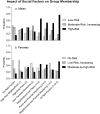Effect of multi-level social risk factors on developmental trajectories of sexual risk behaviors among Bahamian middle-to-late adolescents
- PMID: 39219594
- PMCID: PMC11363737
- DOI: 10.1080/21642850.2024.2397470
Effect of multi-level social risk factors on developmental trajectories of sexual risk behaviors among Bahamian middle-to-late adolescents
Abstract
Background: Few studies have examined how multi-level social factors interact and affect developmental patterns of sexual risk among middle-to-late adolescents who are at risk of experiencing sexual risk behaviors. We examined developmental trajectories of sexual risk behaviors of boys and girls in middle-to-late adolescence and the effects of exposure to three social risk factors (poor parental monitoring, peer risk, and neighborhood risk).
Methods: We followed 2,332 Bahamian adolescents every six months from Grades 10-12. We used group-based trajectory modeling to identify distinct trajectories of sexual risk behaviors for boys and girls.
Results: We identified three trajectories each for boys and girls. Peer risk and neighborhood risk predicted a high sexual-risk trajectory for boys, and peer risk (alone or combined with other risk factors) had the greatest impact on the membership of moderate-to-high-risk trajectory for girls. Parental monitoring had a relatively small effect on adolescents' sexual risk behavior.
Conclusion: Our results underscore the importance of early identification of adolescents with sexual risk behavior and development of targeted prevention interventions to improve adolescent health outcomes.
Keywords: Sexual risk behaviors; adolescents; developmental trajectories; group-based trajectory modeling; middle-to-late adolescence; social risk factors.
© 2024 The Author(s). Published by Informa UK Limited, trading as Taylor & Francis Group.
Conflict of interest statement
No potential conflict of interest was reported by the author(s).
Figures


Similar articles
-
Stability and Change in Gender Identity and Sexual Orientation Across Childhood and Adolescence.Monogr Soc Res Child Dev. 2025 Aug;90(1-3):7-172. doi: 10.1111/mono.12479. Monogr Soc Res Child Dev. 2025. PMID: 40660930 Free PMC article.
-
Childhood maltreatment and longitudinal trajectories of disordered eating behaviors: sociodemographic moderators and behavior-specific sensitivity analyses.J Eat Disord. 2025 Jul 29;13(1):159. doi: 10.1186/s40337-025-01355-2. J Eat Disord. 2025. PMID: 40731372 Free PMC article.
-
Falls prevention interventions for community-dwelling older adults: systematic review and meta-analysis of benefits, harms, and patient values and preferences.Syst Rev. 2024 Nov 26;13(1):289. doi: 10.1186/s13643-024-02681-3. Syst Rev. 2024. PMID: 39593159 Free PMC article.
-
Behavioral interventions to reduce risk for sexual transmission of HIV among men who have sex with men.Cochrane Database Syst Rev. 2008 Jul 16;(3):CD001230. doi: 10.1002/14651858.CD001230.pub2. Cochrane Database Syst Rev. 2008. PMID: 18646068
-
Education support services for improving school engagement and academic performance of children and adolescents with a chronic health condition.Cochrane Database Syst Rev. 2023 Feb 8;2(2):CD011538. doi: 10.1002/14651858.CD011538.pub2. Cochrane Database Syst Rev. 2023. PMID: 36752365 Free PMC article.
References
-
- Bornovalova, M. A., Gwadz, M. A., Kahler, C., Aklin, W. M., & Lejuez, C. W. (2008). Sensation seeking and risk-taking propensity as mediators in the relationship between childhood abuse and HIV-related risk behavior. Child Abuse & Neglect, 32(1), 99–109. 10.1016/j.chiabu.2007.04.009 - DOI - PMC - PubMed
-
- Braams, B. R., van Duijvenvoorde, A. C., Peper, J. S., & Crone, E. A. (2015). Longitudinal changes in adolescent risk-taking: A comprehensive study of neural responses to rewards, pubertal development, and risk-taking behavior. The Journal of Neuroscience, 35(18), 7226–7238. 10.1523/JNEUROSCI.4764-14.2015 - DOI - PMC - PubMed
-
- Census Office . (2023). 2022 census of population and housing. https://www.bahamas.gov.bs/wps/wcm/connect/c0d9fae8-54df-49e3-b4b9-92e29...
Grants and funding
LinkOut - more resources
Full Text Sources
